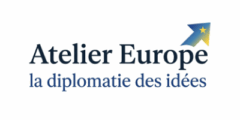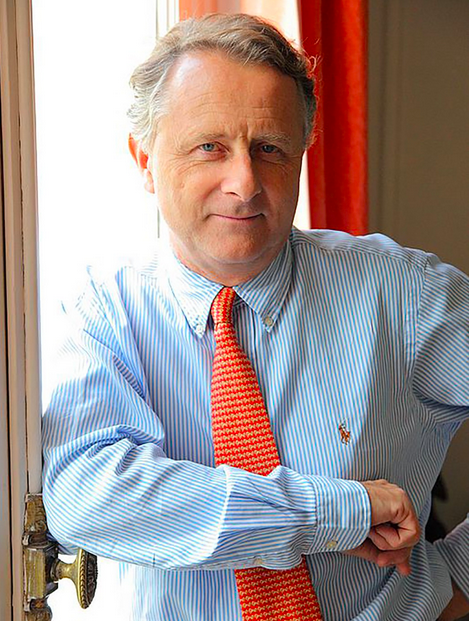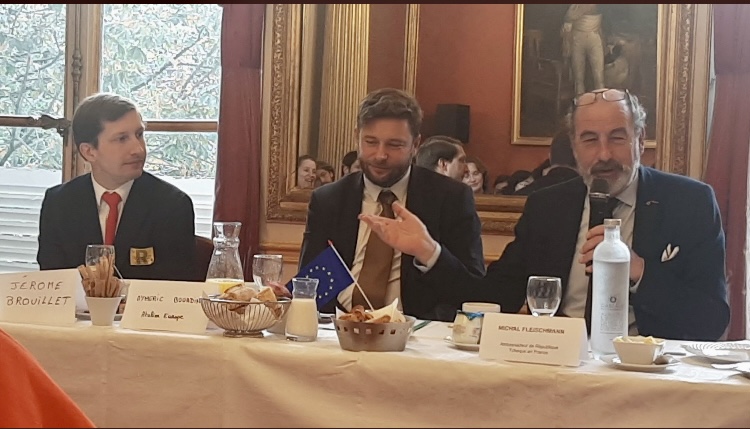Par Patrick d’Humières

La guerre a changé l’Europe et son projet ; la France doit en tirer toutes les conséquences
La dynamique militaire de l’Union est en train de déplacer le centre de gravité européen. Difficile de dire si depuis que le soutien à l’Ukraine mobilise l’essentiel des énergies à Bruxelles, la France longtemps avant-centre de l’équipe européenne, ne se trouve pas reléguée au milieu du terrain, sinon en défensive, tant l’agenda s’est transformé et les positions se sont déplacées ! A la limite, peu importe, si l’essentiel reste l’unité des 27 et si le passage à une « Europe puissance » avance. La France y a sa part déterminante. Pour autant, les enjeux ont bougé au profit des dimensions militaires, diplomatiques, énergétiques et technologiques. Sur ces questions où la France avait sa singularité, il lui faut désormais jouer beaucoup plus collectif si elle veut faire valoir sa place. ; ce reclassement induit une révision de ses logiciels historiques. Cela vaut aussi pour l’Allemagne.
La conséquence politique de ceci sera au cœur du débat public des élections de 2024. Il faut dire à nos compatriotes que l’enjeu du vote n’est plus de ménager la souveraineté française et de faire cohabiter une double souveraineté nationale et communautaire, satisfaisant à la fois les tenants du passé et de l’avenir : nous y perdrions notre capacité d’influence. Il s’agit de placer la stratégie française au centre de gravité de la stratégie européenne pour en être un acteur complet, compris et contributif, qui aide à l’émergence de solutions audacieuses et dynamiques. Notre plus grand risque est d’être marginalisé dans le mouvement qui force l’Union à répondre à l’appel historique à être le 3° bloc mondial ; Partie prenante du monde occidental, l’Union devra couvrir le spectre de la puissance qui va du poids commercial au poids militaire et du poids des valeurs au poids des alliances. Sur le grand défi climatique planétaire, elle pourra apporter des solutions et face à la fragmentation géopolitique elle pourra apporter son savoir-faire de régulation. Qui aurait cru que l’Union aurait cette opportunité de remonter en première division mondiale ? Si la France en est un moteur et un facilitateur, cela dessinera sa stratégie pour longtemps.
D’abord libérer le front ukrainien; la victoire militaire ouvrira la voie géopolitique.
Tous les européens l’ont compris désormais : le projet d’Union Européenne est conditionné par le retour de l’Ukraine dans ses droits et l’instauration d’une sécurité collective sur le front Est, à partir de quoi tous les autres sujets de progrès retrouveront un sens. En attendant, l’Ukraine est notre nouvelle frontière. Tant qu’elle ne sera pas stabilisée, l’Union devra assumer un maximum d’efforts, militaires, économiques, humanitaires, non pour abattre la Russie, mais pour démontrer qu’elle est capable de défendre un projet politique, y compris dans sa dimension militaire.
Au moins le message est clair : l’UE doit assurer une perspective commune, sécuritaire et diplomatique, démocratique et solidaire aussi, aux populations allant de l’Atlantique au Dniepr, et de la Baltique à la Méditerranée. Nous savons désormais ce que nous avons en commun et que ce projet peut compter dans un jeu mondial menaçant et sans pilote.
Cette revendication d’une Europe géopolitique fut au cœur du message bruxellois depuis le départ du Royaume-Uni, qui nous a confronté paradoxalement au vertige d’un
isolement continental auquel « la structure communautaire » a su parfaitement réagir. Nous sentions qu’il fallait se donner une vocation mondiale, hors de quoi l’Union se perdrait dans ses débats de concurrence économique. Le mercantilisme ne suffit pas à répondre aux interrogations internationales que perçoivent tous les européens. Leur expérience historique lourde et dramatique a intégré ces questions au cœur des familles et des cultures.
Ce rebond doit beaucoup aux circonstances mais l’important n’est-il pas de s’en saisir ?
Le moment historique est fort et l’Union l’affronte avec intelligence, cohésion et audace même, osons le dire ! Quand il s’est agi d’acheter sur le marché mondial, de faire valoir des principes de droit contre des opérateurs hors contrôle et de soutenir les zones affectées par le conflit, l’UE a montré qu’elle savait faire. Mais cette situation ne règle pas pour autant les grands dossiers attendus par les opinions, car très identitaires, comme la politique d’immigration, la cohérence sociale et la protection aux frontières de nos productions nationales. Alors qu’il va falloir un jour se confronter à la dernière vague d’élargissement si l’on veut achever un processus d’union continentale et savoir construire une défense qui associe la solidarité atlantique et occidentale avec un mécanisme de souveraineté propre, la réussite à saluer est bien celle du Green Deal, qui a démontré que l’on pouvait négocier une entrée sérieuse dans l’économie écologique répondant au défi climatique, avec une dynamique industrielle qui affirme sa compétitivité, face à la Chine mais aussi aux Etats-Unis. Rappelons que ce ne sont pas les normes qui pèsent sur nos coûts, surtout si on les impose à nos concurrents, mais plus souvent l’absence d’innovation qui nous disqualifie ! Qui peut croire que sans un cadre qui organise la rupture, nos économies rentières auraient engagé les sauts technologiques attendus ?
Penser l’Union, c’est penser un projet démocratique et humain
La difficulté est plus dans nos têtes que dans nos forces ! Il y a encore en Europe une psychologie collective corsetée par les codes d’Ancien Régime, qui font croire que nos vieux pays ont besoin de claironner chacun autour de leur drapeau. Mais les opinions ne sont plus dupes et préfèrent appuyer un rapport européen au monde qui pèse efficacement dans la négociation géopolitique que d’assister à des combats de
coq ! Certains appellent même à la naissance d’une nation européenne, considérant que les budgets de défense remplaceront allègrement une constitution mort-née. La réalité est qu’une intelligence collective européenne s’affirme sans avoir besoin de s’en prendre aux symboles et aux porteurs des identités nationales. On remerciera les Ukrainiens d’avoir mis notre confédération d’États Nations au défi d’une capacité d’action stratégique. Mais ne manque-t-il pas à cette dynamique nouvelle un fil conducteur qui parle au cœur des européens, non pas de façon défensive et guerrière, mauvaise conseillère, mais de façon constructive et humaine, pour renouer avec le fond d’humanisme qui est notre dénominateur commun ?
Un projet de reconstruction de l’ordre mondial qui ne naîtra pas de la conflictualité sino-américaine mais bien d’une offre nord-sud que nous saurons proposer ensemble
Notre expérience ancienne des traités de paix, certains ratés, d’autres réussis, doit nous éclairer à ce sujet. Outre la reconstruction, qui est la priorité pour intégrer l’Ukraine dans de bonnes conditions, il y a un défi évident qui est l’application des garanties négociées, reposant sur une dissuasion conventionnelle adaptée, qui remette l’Europe en gardien de ses frontières dans le cadre de l’OTAN, seule alliance militaire crédible à ce jour. C’est là une première révision importante de la stratégie de défense française qui devra en tirer des conséquences pour ses nouvelles priorités, ses modes de décision et d’action. Si ce tournant est pris, il entraînera automatiquement celui des synergies diplomatiques qu’il faudra favoriser, à travers nos outils et nos démarches à « communautariser » de plus en plus, mais aussi en acceptant d’européaniser complètement une stratégie africaine qui glisse sous nos pieds. Il nous faudra lâcher les nostalgies impériales qui nous encombrent, au profit d’un projet de reconstruction collective de l’ordre mondial qui ne naîtra pas de la conflictualité sino-américaine mais bien d’une offre nord-sud que nous saurons proposer ensemble.
Ce réalignement d’une vision globale ne peut plus se contenter de poursuivre la prospérité par tous les moyens, mais doit bien plutôt favoriser une planète durable pour une vie humaine, juste et équitable partout, en mettant notre expérience et notre puissance au service des enjeux collectifs. Cela répond à la question ontologique : à quoi sert l’Europe ? En redonnant cette orientation simple à notre projet, nous
pourrons mobiliser à la fois les générations nouvelles et les aspirations critiques, condition indispensable de toute construction démocratique, mais aussi ouvrir un champ nouveau de la vie en société au 21°siècle. Cela nécessitera de favoriser la capacité d’expression de chacun par l’éducation, la culture, l’échange, dans le respect des droits et des diversités. Contrairement au projet d’après-guerre qui laissait entendre que l’attraction de l’Occident reposait sur la perspective pour chaque ménage de multiplier à l’infini les voitures, les frigidaires et les voyages en avion, le projet qui s’impose aujourd’hui au nord comme au sud, au nom d’une planète finie et souffrante, est celui d’une vie commune qui économise la ressource et préserve la régénération des écosystèmes, pour permettre à chacun d’exprimer sa vocation personnelle au service d’une humanisation des sociétés à laquelle il faut croire.
La France doit percevoir l’opportunité d’adhérer à un projet global européen
Le projet européen porte cela car il a su dominer ses échecs passés. En combattant toujours ses démons et ses fantômes régressifs, il reste un espace privilégié, sinon unique, où la démocratie est plus qu’une série de droits : une exigence spirituelle collective inextinguible. Soyons conscients que nous sommes des acteurs déterminants de cette mutation civilisationnelle qui nous sollicite, allant du retour de la barbarie absolue aux utopies les plus universelles et que nous devons faire en sorte que l’emportent les valeurs humaines en jeu derrière les valeurs politiques en débat et les controverses qui animent notre vie nationale. L’on pourrait faire des rapprochements avec d’autres périodes comparables qui ont vu s’affronter des envolées progressistes et des pessimismes désabusés. On ne dira pas que nos défis sont plus considérables et plus risqués que jamais, mais on ne devra pas manquer de se dire que si la France se justifie plus que jamais par sa promesse d’intégration réussie, c’est d’abord pour la mettre au service d’un idéal européen qui n’est plus dissociable du sien. Cela lui donnerait la possibilité nouvelle d’accomplir son projet en le partageant avec ses voisins les plus proches, avec lesquels elle a vécu depuis plus de mille ans une aventure chaotique, afin de rester dignes, ensemble, de ce que l’on a fait de mieux. Et si les décennies qui viennent redevenaient un temps de civilisation en Europe ?
Pour Atelier Europe, Patrick d’Humières Avis & contact : pdh@company21.fr




